This was published 7 years ago
Abu Dhabi things to do: The Louvre and five other must-do highlights
By Steve Meacham
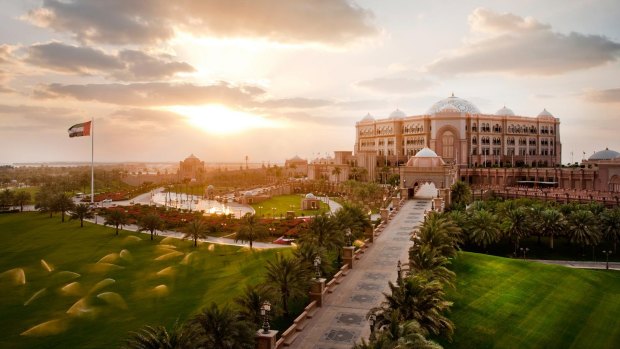
Emirates Palace.
The Louvre is looking lovely tonight, illuminated in the twilight balm after the sun has set over the Arabian Gulf.
Its shallow dome sparkles like a thousand stars in the desert night sky – an elegant addition to the canon of Middle Eastern architecture.
Due to open in 2017, Louvre Abu Dhabi was designed by Jean Nouvel, the French Pritzker Prize-winning architect. His signature 80-metre diameter white dome, he says, evokes comparisons with "mosque, mausoleum and madrasa".
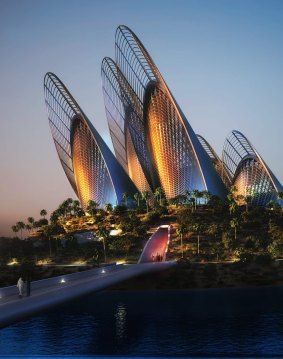
Zayed National Museum.
By day, the carefully designed pattern of geometric openings will allow soft shafts of light into the museum, inspired by the effect date-palm leaves create when used as the roofing material in traditional homes.
By night, those same holes will twinkle magically as they are doing – for the first time – to coincide with tonight's opening of the 2016 Abu Dhabi Art fair.
We're told the new Louvre – a partnership between France and the emirate of Abu Dhabi – will be a world-class museum dedicated to exploring the links and influences between various cultures. That it will provide a unique insight into the history of humankind through artworks, sculptures and objects never normally seen together under the same roof.
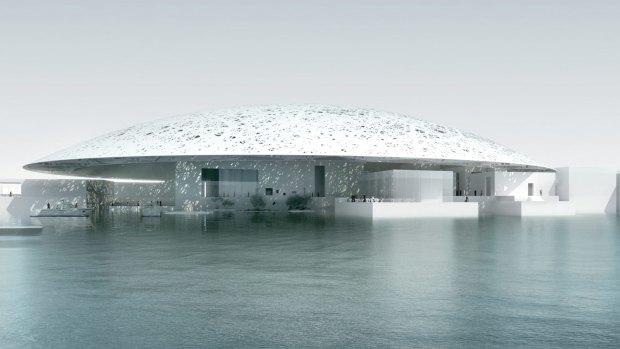
The Louvre, Abu Dhabi.
And yet Louvre Abu Dhabi is merely the first of five iconic new museums – each designed by globally renowned architects – already conceived, approved and intended to transform Abu Dhabi into an international arts and cultural hub.
Sir Norman Foster's Zayed National Museum, with soaring wings inspired by a desert falcon's feathers, will be the centrepiece of the city's new Saadiyat Island Cultural District. This memorial to the falcon-loving, founding president of the United Arab Emirates – the late Sheik Zayed bin Sultan Al Nahyan – will showcase the transformation of the UAE from its Bedouin past to its oil-rich present.
Three other master architects unveiled their work in 2007. Frank Gehry's Guggenheim Abu Dhabi has been much delayed since the concrete piles were poured in 2011, but the 42,000-square-metre design is as striking as Gehry's most famous work, Guggenheim Bilbao. The late Iraqi-born British architect, Zaha Hadid – the first woman to win the Pritzker Prize – delivered her design for the Abu Dhabi Performing Arts Centre at the same 2007 launch, as did Japan's Tadao Ando for the proposed maritime museum celebrating the UAE's seafaring history.
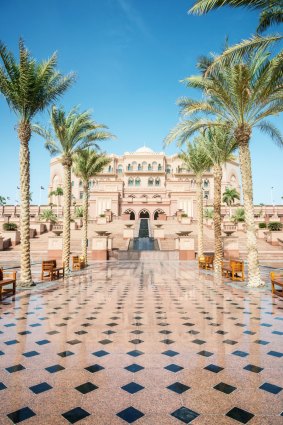
The Emirates Palace in Abu Dhabi.
All but Louvre Abu Dhabi are years away from completion. Yet the capital of the UAE capital (why do so many visitors think that's Dubai?) already has some architectural wonders that tend to have been overshadowed by the ostentatious extravagances of its more famous little brother?
So what's worthy of your attention?
SHEIK ZAYED GRAND MOSQUE
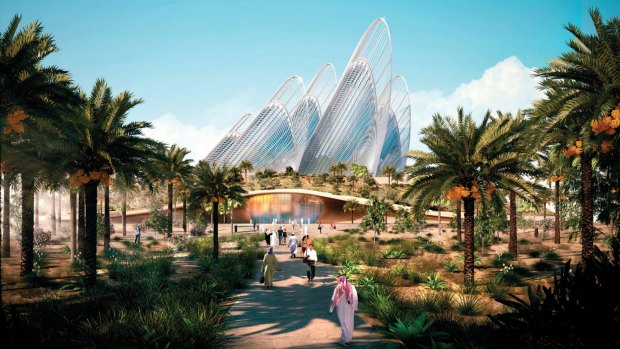
Zayed National Museum.
According to TripAdvisor's 2016 Traveller's Choice awards, the grand mosque was voted the second most outstanding landmark on the planet after Machu Picchu (ahead of Angkor Wat, St Peter's Basilica and the Taj Mahal).
While that's suspect, there's no denying this is one of the largest and most awe-inspiring mosques in the world, capable of holding 41,000 worshippers at a time.
Opened in 2007, it took 11 years to build and was the vision of the man it is named after, Sheik Zayed (whose mausoleum is on the same site). Multiple architects were involved in delivering his dream of "uniting the world" through a design which melds three different styles of mosque architecture (Persian, Moorish and Moghul) using artisans and materials from Italy to India, Morocco to Malaysia.
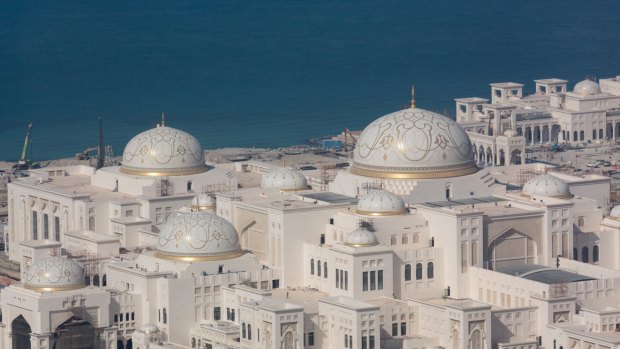
The enormous new Presidential Palace in Abu Dhabi.
Breathtakingly serene in white marble and 24-carat gold leaf, with 82 domes, four minarets, 1000 columns, seven of the largest chandeliers ever made and the world's largest hand-knitted carpet (made in Iran using New Zealand wool), the mosque still manages to be a place of solemn beauty and contemplation despite its extravagance.
Plan your visit to coincide with one of the complimentary, hour-long guided tours in English and be sure to adhere to the strict dress code. See: szgmc.ae/en/
ABU DHABI PRESIDENTIAL PALACE
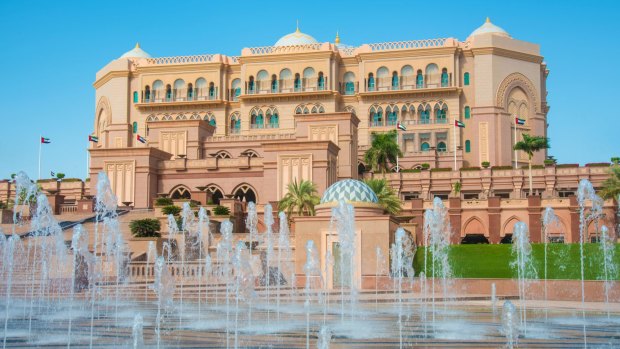
Fountains in front of the Emirates Palace in Abu Dhabi.
The public can't enter what is reputed to be the most expensive presidential palace ever built, but you can certainly marvel at its opulence from afar.
Sprawling over 150 hectares of oceanfront property next to the Emirates Palace Hotel, the multi-domed, gleamingly white complex was designed by the Abu Dhabi-based Ewan Architectural & Engineering Consultancy.
More than a residence for the current president of the UAE (Sheik Zayed's son, Khalifa bin Zayed Al Nahyan), it is the seat of UAE government, containing the offices of the vice-president, the Crown Prince, and various ministers.
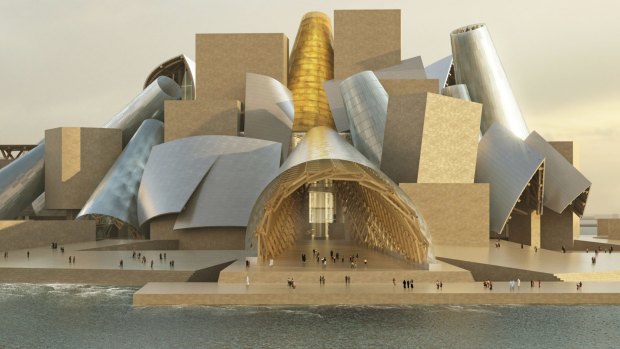
Yet to be completed: the Guggenheim Abu Dhabi.
The central palace is more than 16,000 square metres and includes several VIP wings, Majlis (traditional meeting spaces) and dining halls as well as a media hall and press centre. The 23,000 square metres of ancillary buildings incorporate a mosque, a military base and an impressive collection of triumphal arches, gatehouses and watchtowers.
EMIRATES PALACE HOTEL
When it comes to UAE hotels, most people immediately think of Dubai: Burj Al Arab Jumeirah, perhaps?
But when it opened in 2006, the Emirates Palace was the most expensive hotel ever built, costing a reputed $US3 billion (it's now No. 2, after Singapore's Marina Bay Sands).
Designed by the British-born John Elliott, of Wimberly, Alison, Tong and Goo, the self-proclaimed "world's first seven-star hotel" was deliberately conceived, financed and built by the Abu Dhabi government to make a grand statement about the city's emergence on the global stage.
The main sand-coloured, 114-domed building stretches over a kilometre from wingtip to wingtip, surrounded by 40 hectares of lush gardens between the Corniche and the hotel's private beach and marina.
Even if you can't afford to stay in one of the 302 rooms or 92 suites, it's worth a visit to see the vast marble-lined lobby with its massive central dome 72 metres above the ground. Order the hotel's signature "gold-flaked cappuccino" (yes, that really is a dusting of 24-carat edible gold leaf on top of the coffee), or splash out on the perfect memento (where else can you put money into an ATM and get a piece of gold at the immediate market rate).
The top floor "ruler suites" are reserved for heads of state or government (George W. Bush and Tony Blair are previous occupants).
However, if you have a cool $US15,000 to spare, book a night in one of the opulent suites on the floor below where the likes of Elton John, George Michael and Michael Jackson have stayed (though not at the same time).
FERRARI WORLD
Perhaps the first thing you'll see as you fly into Abu Dhabi is the gigantic, curved red roof of the only amusement park in the world dedicated to a Formula 1 icon.
Ferrari World, opened in 2010, was declared the leading tourist attraction in the Middle East in the 2015 World Travel Awards.
The award-winning design – the largest "space frame structure" ever built – is the work of the international Benoy group.
Due to the shape of the site, the distinctive building "was conceived as a simple ground-hugging form, growing from the landscape in flowing lines like a red sand dune". Its design pays homage both to the Ferrari marque and "the sinuous double curves of countless Ferrari body shells".
Now housing more than 20 rides (including Formula Rossa, the world's fastest rollercoaster), Ferrari World is the largest indoor amusement park on earth, its 200,000-square-metre roof capable of expanding and contracting with Abu Dhabi's challenging temperature changes. See ferrariworldabudhabi.com
YAS VICEROY ABU DHABI HOTEL
Yes, this is the only five star hotel in the world built over a Formula 1 race track – the Yas Marina Circuit which now hosts the final, 21st contest of the season.
But the futuristic design, by Hani Rashid and Lise Anne Couture of New York's Asymptote Architecture, would win applause wherever it was sited.
Opened in 2009, the concept is relatively simple. Two fairly conventional 12-storey hotel towers form the skelton – one set within the race circuit and the other within the marina, connected by a glass and steel bridge over the track.
But over this, Rashid and Couture wrapped a spectacular, sweeping web of glass and steel known as the Grid Shell.
While this is elegant by day, it truly comes into its own at night – thanks to over 5000 colour-changing LED lights.
Treat yourself to dinner or a cocktail at one of the hotel's seven restaurants or three bars, and marvel at the imaginative light show. See viceroyhotelsandresorts.com/en/abudhabi
TRIP NOTES
MORE
FLY
Etihad Airways flies twice daily to Abu Dhabi from Sydney and Melbourne, and daily from Brisbane and Perth. Economy from $1970 (see etihad.com).
Steve Meacham was a guest of Abu Dhabi Tourism and Culture Authority and Etihad Airways.
Sign up for the Traveller Deals newsletter
Get exclusive travel deals delivered straight to your inbox. Sign up now.